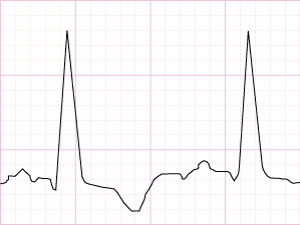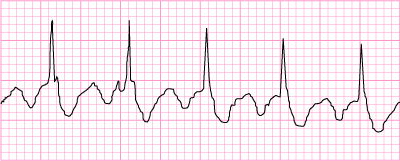Cardiology Teaching Package
A Beginners Guide to Normal Heart Function, Sinus Rhythm & Common Cardiac Arrhythmias
Atrial Flutter
Image: Sinus Tachycardia (close up)

Although the rate is 140 bpm, it is possible to clearly identify the P wave, QRS complex and T wave.
Image: Sinus Tachycardia (full strip)

Atrial Flutter with 4:1 Block
Image: Atrial Flutter (with 4:1 block)

Image: Atrial Flutter with 4:1 block(full strip)

Notice how the flutter waves are clearly defined like the teeth of a saw. There are 4 flutter waves between each QRS complex and the rate is 75 bpm. (4 large squares divided into 300)
Atrial Flutter with 2:1 Block
Image: Atrial Flutter (with 2:1 block)

Image: Atrial Flutter (full strip)

The rhythms above are still atrial flutter but the rate is now 150 bpm. Too fast to analyse if the rhythm is regular. But because the rate is 150 bpm it is likely to be atrial flutter with 2:1 block.
